The West Coast might have its Comic-Con this week, but the East Coast will be enjoying animated films at the 11th annual Animation Block Party, which starts tomorrow and continues through Sunday.
Add a CommentViewing: Blog Posts Tagged with: John Hubley, Most Recent at Top [Help]
Results 1 - 8 of 8
Blog: Cartoon Brew (Login to Add to MyJacketFlap)
JacketFlap tags: Space Jam, Farmer Alfalfa, John Hubley, Events, Brooklyn, Animation Block Party, Animation Breakdown, Add a tag
Blog: Cartoon Brew (Login to Add to MyJacketFlap)
JacketFlap tags: Ideas/Commentary, Nick Park, documentary, Audition, Ryan, Wonderland, Aardman Animations, Windy Day, Chris Landreth, John Hubley, Peter Lord, Creature Comforts, Faith Hubley, Waltz with Bashir, Animated Conversations, Audio production, Colin Thomas, Confessions of a Foyer Girl, David Sproxton, Down and Out, Hangovers, Jonathan Hodgson, Moonbird, Orly Yadin, Sylvie Bringas, The Trouble with Love and Sex, William Mather, Add a tag
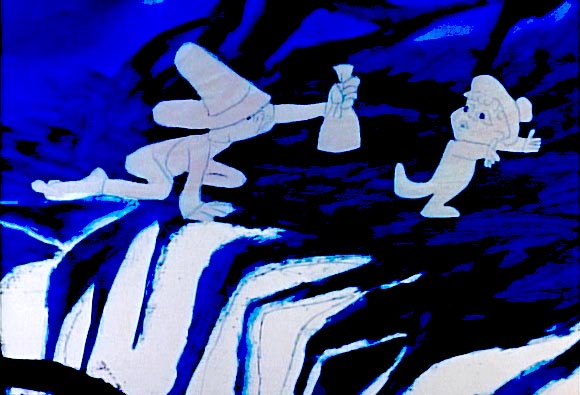
One of the better-known shorts made by John and Faith Hubley is Moonbird, from 1959. This film came about when the Hubleys made a secret recording of their two sons one night, playing a game in which they pretended to be hunting for the elusive Moonbird. The result was a soundtrack with a complete narrative, courtesy of the two children; the Hubleys and their studio then visualised the story to create the film.
It is surprising how well Moonbird works, considering that its story is simply two kids making things up as they go along. The personalities of the children come through very strongly and much of the recorded dialogue is inherently funny, as when the younger boy tries to recite “Hey Diddle Diddle” but has trouble remembering past the second word.

Moonbird was followed by the 1967 film Windy Day, based on the same concept but using the voices of the Hubleys’ two daughters. This short is much looser, with a transformative element as the two characters morph from one identity to another. Instead of a single narrative, the children deliver a free-flowing conversation which makes several twists: The two girls start by playing at being a knight and a princess, and later play at being animals; between these sessions they discuss birth, adulthood, marriage and death in the half-grasped manner of children.
Windy Day was shown at the 1968 Cambridge Animation Festival; amongst the people who saw it were producer Colin Thomas and animator William Mather.
“We were blown away by the use of raw unpolished sound with a highly controlled medium like animation”, said Mather in an interview I conducted with him in 2011. In 1975 the two put together a pilot film entitled Audition, based around a recording of Mather’s son talking to an organ player as he auditioned for the role of a choirboy.
The film is very different to Hubley’s shorts. Aside from a very brief sequence in which the boy imagines the organ turning into a monster, it does not take place in a world of childhood fantasy: Its aim is instead to recreate the conversation in more straightforward cartoon terms.
The Hubleys sought to create fantasy films when they made Moonbird and Windy Day, and turned to the taproot of so much fantasy: the imaginations of children. By contrast, Mather and Thomas created a film which was closer to documentary. It is worth noting that Thomas was a documentary filmmaker, and that BBC Bristol – the branch for which the two men made their pilot – has a strong documentary tradition.

The pilot led to Animated Conversations, a six-part series produced in the late-1970s by various directors. Mather contributed Hangovers, based on a recording of a barmaid and her customers, but the best-known shorts for this series were made by Aardman founders Peter Lord and David Sproxton.
The two Aardman shorts take quite different approaches. Down and Out is a literalistic portrayal of an elderly man being turned away from a hostel which – unlike Mather’s shorts – lacks any humor; its emphasis is instead on pathos. Confessions of a Foyer Girl, on the other hand, plays its material for laughs. A young cinema employee discussing the banal details of her day-to-day life is contrasted with the glamorous and exciting world of the movies.
Lord and Sproxton’s work on Animated Conversations prompted Channel 4 to commission its own series of animation based on natural dialogue, this time made entirely by Aardman: Late Edition, Sales Pitch, On Probation, Early Bird
and Palmy Day. As before, some of these went for wacky comedy, while others opted for melancholy tones.
Aardman’s subsequent work in this format includes Creature Comforts by Nick Park. As well as ranking as the single most famous example of the approach, it is one of the more playful in using its soundtrack. As the film is framed as a series of short interviews with various characters, Park was able to home in on the soundbites with the most comic potential. The earlier shorts built themselves around large chunks of undigested conversation, but the whole point of Creature Comforts is that the interviewees are quoted completely out of context.
Creature Comforts became an entire franchise, and in is now the key example of what is, today, a full-fledged genre of animation.
Sometimes the approach can serve a practical use. Animation students are often assigned the task of working to found soundtracks as lipsync exercises. “The Trouble with Love and Sex,” a 2011 episode of the BBC documentary series Wonderland, focused on people undergoing counselling; when it ran into the problem that these people were not comfortable being filmed, it simply used their voices, the visuals being animated by Jonathan Hodgson.
Meanwhile, other animators returned to the daring ethos of the Hubley shorts. Chris Landreth’s Ryan plays with intertextuality, using animation to illustrate interviews with and about animator Ryan Larkin. Sylvie Bringas and Orly Yadin’s’s Silence presents a child’s eye view of the Holocaust, alternating between harsh, woodblock-like sequences for the camp scenes and a softer, more childlike style for the postwar sequences.

There are three general approaches taken by these films. The first is a literalistic portrayal of the conversation, as with the melancholy Down and Out, the lighthearted Late Edition and the harrowing Waltz with Bashir (the last of these being the only feature-length animation of this type that I am aware of.) The second approach creates comedy by placing ordinary dialogue into an unusual situation, as with Creature Comforts.
Finally, the third approach uses animation to illustrate the more subjective aspects of the soundtrack, usually by attempting to recreate the mental state of the speaker. Examples include Silence, Ryan, Marjut Rimminen’s Some Protection, Paul Vester’s Abductees and Andy Glynne’s Animated Minds.
Jan Svankmajer once remarked that “animators tend to construct a closed world for themselves, like pigeon fanciers or rabbit breeders.” When an animated film uses unscripted audio, what we see is pure fantasy, but what we hear is an actual moment in time—the closed world of animation is suddenly opened up to stark reality.
IMAGES AND VIDEO IN THIS PIECE
1.) Still from Moonbird
2.) Still from Windy Day
3.) Audition
4.) Still from Confessions of a Foyer Girl
5.) Still from Creature Comforts
6.) Clip from “The Trouble with Love and Sex”
7.) Still from Waltz with Bashir
Blog: Cartoon Brew (Login to Add to MyJacketFlap)
JacketFlap tags: Ideas/Commentary, John Lasseter, Bob Clampett, Ward Kimball, Bill Plympton, Don Bluth, Hayao Miyazaki, Genndy Tartakovsky, Chuck Jones, Brad Bird, Frank Tashlin, Don Hertzfeldt, Friz Freleng, John Kricfalusi, Joe Barbera, Frederic Back, John Hubley, Joanna Quinn, Lotte Reiniger, Bill Hanna, Bruno Bozzetto, Emile Cohl, Walt Disney, Nick Park, Seth MacFarlane, Ralph Bakshi, Pen Ward, Richard Williams, Winsor McCay, Tex Avery, Pete Docter, Add a tag
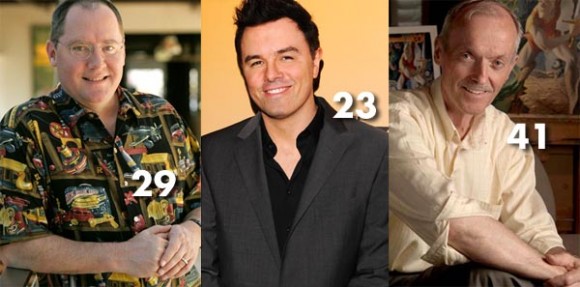
“Animation is a young man’s game,” Chuck Jones once said. There’s no question that animation is a labor-intensive art that requires mass quantities of energy and time. While it’s true that the majority of animation directors have directed a film by the age of 30, there are also a number of well known directors who started their careers later.
Directors like Pete Docter, John Kricfalusi and Bill Plympton didn’t begin directing films until they were in their 30s. Don Bluth, Winsor McCay and Frederic Back were late bloomers who embarked on directorial careers while in their 40s. Pioneering animator Emile Cohl didn’t make his first animated film, Fantasmagorie (1908), until he was 51 years old. Of course, that wasn’t just Cohl’s first film, but it is also considered by most historians to be the first true animated cartoon that anyone ever made.
Here is a cross-selection of 30 animation directors, past and present, and the age they were when their first professional film was released to the public.
- Don Hertzfeldt (19 years old)
Ah, L’Amour
Ah, L’Amour
The Ornament of the Lovestruck Heart
Tapum! The History of Weapons
Hook & Ladder Hokum
Little Red Riding Hood
Fiery Fireman
Larry & Steve
2 Stupid Dogs (TV)
Porky’s Badtime Story (or 23 if you count When’s Your Birthday)
Adventure Time (TV)
Girl’s Night Out
Gadmouse the Apprentice Good Fairy
The Night Watchman
The Little Island
Gold Diggers of ’49
Blue Monday
Puss Gets the Boot
Old Blackout Joe
Luxo Jr.
Amazing Stories: “Family Dog” (TV)
Rupan Sansei (TV)
A Grand Day Out
Mighty Mouse: The New Adventures (TV)
Monsters Inc.
Adventures in Music: Melody
Boomtown
How a Mosquito Operates
The Small One
Abracadabra
Fantasmagorie
Blog: Cartoon Brew (Login to Add to MyJacketFlap)
JacketFlap tags: John Hubley, Faith Hubley, Picasso, Feature Film, Pablo Picasso, The Picasso Summer, Wes Herschensohn, Add a tag

This one is new to me. The Picasso Summer is a 1969 feature based on a Ray Bradbury short story. It includes an impressively lengthy animated sequence based on Picasso’s artwork that holds up on its own.
The animation is credited to Wes Herschensohn, who was a producer on the film and also an animation veteran. But this in-depth article about the film claims the animation was produced by John and Faith Hubley. Based on the style, it’s entirely plausible that the Hubleys provided the animation, though I’ve never heard of them being associated with the project. Whoever made this, it’s a unique interpretation of Picasso’s artwork into animation, and deserves more attention than it has received.
Add a CommentBlog: Cartoon Brew (Login to Add to MyJacketFlap)
JacketFlap tags: Ralph Bakshi, Robert Breer, John Hubley, John Whitney, Museum of Arts and Design, Sally Cruikshank, Events, Add a tag
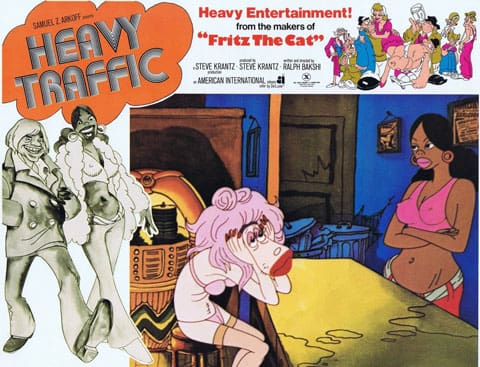
It all kicks off on September 27th at New York’s Museum of Art and Design (aka MAD) with a screening of the works of James and John Whitney. This is followed in mid-October every Friday and Saturday with a curated series of screenings dedicated to Ralph Bakshi, The Hubleys, Sally Cruikshank, Martha Colburn, Jim Trainor and Robert Breer. The restrospective is called Adults in the Dark: Avant-Garde Animation at MAD and it runs through mid-November. It’s an important compilation of landmark animated works by some of the true artists in the field. New Yorkers, check it out!
(Thanks, Aaron Anderson)
Add a CommentBlog: Cartoon Brew (Login to Add to MyJacketFlap)
JacketFlap tags: Events, Animators, John Canemaker, John Hubley, Faith Hubley, Add a tag
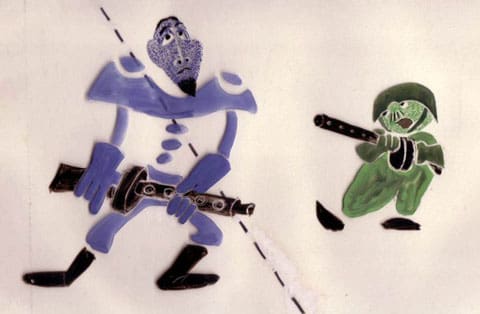
If you are in Southern California (or Northern California, the west coast or anywhere west of the Mississippi) you are summoned to what sounds like an incredible evening at the Motion Picture Academy in September. Oscar winning animator and acclaimed animation historian John Canemaker will present an illustrated lecture and screening of the lives and work of independent animators John and Faith Hubley on Friday, September 14th, at the Academy of Motion Picture Arts and Sciences (AMPAS) in Los Angeles.
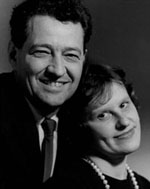 Canemaker will host an in-depth, intimate look at the life and work of these two iconoclastic artists, including screenings of Flat Hatting, The Ragtime Bear, Rooty Toot Toot; Storyboard, Inc. TV commercials; Faith Hubley’s Northern Ice Golden Sun; John and Faith Hubley’s Adventures of an *, The Tender Game, The Hole, Windy Day, Voyage to Next, and newly discovered footage of a never-completed animatic by the Hubleys of Edith Sitwell and William Walton’s Facade. Anyone who’s been to any of Canemaker’s lectures know these are not to be missed.
Canemaker will host an in-depth, intimate look at the life and work of these two iconoclastic artists, including screenings of Flat Hatting, The Ragtime Bear, Rooty Toot Toot; Storyboard, Inc. TV commercials; Faith Hubley’s Northern Ice Golden Sun; John and Faith Hubley’s Adventures of an *, The Tender Game, The Hole, Windy Day, Voyage to Next, and newly discovered footage of a never-completed animatic by the Hubleys of Edith Sitwell and William Walton’s Facade. Anyone who’s been to any of Canemaker’s lectures know these are not to be missed.
Tickets for An Academy Salute to John and Faith Hubley go on sale later today, Mon. July 30th, online – and you can get yours if you click here. See you there!
Cartoon Brew |
Permalink |
No comment |
Post tags: Faith Hubley, John Canemaker, John Hubley
Blog: Cartoon Brew (Login to Add to MyJacketFlap)
JacketFlap tags: Animators, Classic, Bob Clampett, Warner Bros., Chuck Jones, Frank Tashlin, Michael Barrier, Friz Freleng, John Hubley, Pete Burness, Phil Monroe, Add a tag
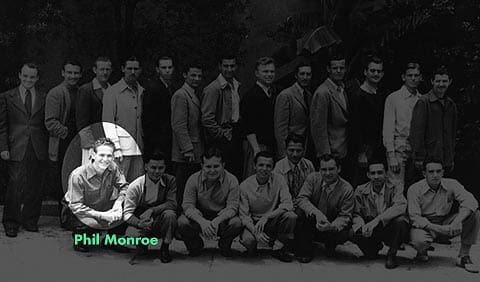
Golden Age animator Phil Monroe (1916-1988) is rarely discussed, even amongst animation cognoscenti, which is unfortunate because he had an amazing career. Over the course of his career, he animated for an honor roll of legendary directors including Bob Clampett, John Hubley, Chuck Jones, Pete Burness, Friz Freleng, and Frank Tashlin. Animation historian Michael Barrier has posted a never-before-published 1976 interview with Phil Monroe that he and Milton Gray conducted.
The interview delves into details that may appeal to only a small portion of our twenty thousand-plus daily readers, but if you appreciate classic Warner Bros. shorts and animation history in general, the interview is guaranteed to blow your mind. There’s even a great story about how Monroe got Chuck Jones and Friz Freleng to square dance with one another, even though “they were barely on speaking terms.” Barrier conducted a follow-up interview with Monroe in 1987, which he promises to publish online soon.
Cartoon Brew |
Permalink |
No comment |
Post tags: Bob Clampett, Chuck Jones, Frank Tashlin, Friz Freleng, John Hubley, Michael Barrier, Pete Burness, Phil Monroe, Warner Bros.
Blog: Cartoon Brew (Login to Add to MyJacketFlap)
JacketFlap tags: John Hubley, Events, Mary Blair, John Canemaker, Add a tag
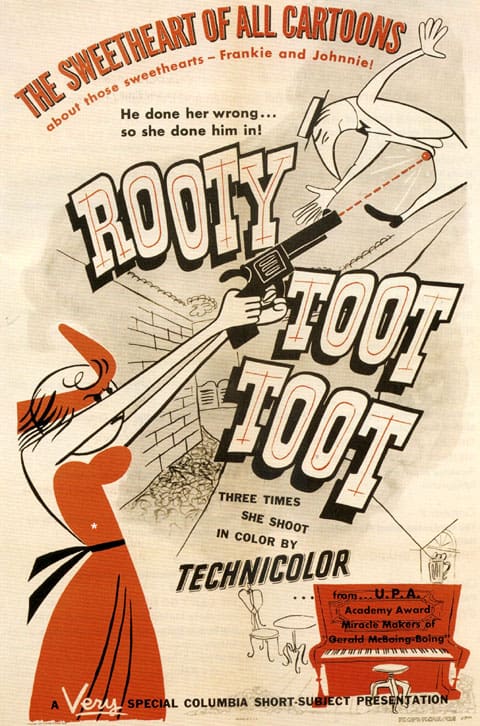
The Academy of Motion Pictures Arts and Sciences has two different programs – one on each coast – worthy of your attention and attendence:
On Monday October 10th An Academy Salute to John Hubley. It will be hosted by Oscar winning animator, educator and author John Canemaker and co-curated by filmmaker Emily Hubley. The program will include rarely seen films and an illustrated look at his life and his art by Canemaker, Hubley and animator Michael Sporn. Tickets are $5 for general admission ($3 for Academy members and students with a valid ID). It will sell-out. Order your Tickets Online NOW!
Monday, October 10, 7 p.m.
Doors open at 6:30 p.m.
Academy Theater at Lighthouse International
111 East 59th Street (between Park and Lexington Avenues), New York City
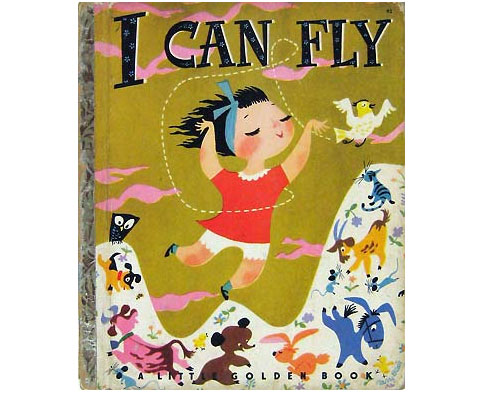
On Thursday October 20th, the 17th Marc Davis Celebration of Animation will present Mary Blair’s World of Color; A Centennial Tribute. This panel will feature Pixar director Pete Docter, Disney animator Eric Goldberg, art director Susan Goldberg, Pixar color key artist Daisuke “Dice” Tsutsumi and character designer Michael Giaimo in a discussion moderated by animation historian Charles Solomon.
Tickets are $5 for general admission ($3 for Academy members and students with a valid ID) and will go on sale starting October 3rd online, by mail, and in person at the Academy Box Office. This too will sell-out. Be there!
Thursday, October 20, at 7:30 p.m.
at the Samuel Goldwyn Theater
8949 Wilshire Boulevard, Beverly Hills
Cartoon Brew: Leading the Animation Conversation |
Permalink |
No comment |
Post tags: John Canemaker, John Hubley, Mary Blair


